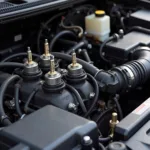An OBD2 reader, also known as an OBD2 scanner, is an essential tool for car owners who want to stay on top of their vehicle’s health and maintenance. One of the most sought-after features of an OBD2 reader is its ability to clear emission-related trouble codes, commonly referred to as “clearing emissions.” This article will delve into the process of how an OBD2 reader clears emissions, its implications, and limitations.
How an OBD2 Reader Clears Emission Codes
Your car’s computer system, also known as the Engine Control Unit (ECU), constantly monitors various sensors and components related to the engine and emissions system. When it detects an issue, it logs a specific Diagnostic Trouble Code (DTC) in its memory. These codes can range from minor issues like a loose gas cap to more serious problems affecting the catalytic converter or oxygen sensors.
An OBD2 reader, when connected to your car’s OBD2 port (usually located under the dashboard), can communicate with the ECU, read these stored DTCs, and display them on its screen. This allows you to understand what’s potentially wrong with your vehicle’s emissions system. Once the issue causing the trouble code is rectified, you can then use the OBD2 reader to clear or erase the code from the ECU’s memory.
Important Considerations When Clearing Emission Codes
While clearing emission codes with an OBD2 reader might seem straightforward, it’s crucial to remember that this action doesn’t magically fix the underlying problem that triggered the code in the first place.
Here are key points to keep in mind:
- Clearing codes is not a permanent solution: If the root cause of the emission-related issue is not addressed, the DTC will likely reappear once the ECU runs its diagnostic tests again.
- Importance of proper diagnosis: Before clearing any codes, it’s crucial to properly diagnose the underlying cause of the issue. Simply erasing the code without fixing the problem can lead to further damage and potentially more costly repairs down the line.
- Readiness monitors: Modern vehicles are equipped with “readiness monitors” that track the performance of various emissions-related components. When you clear emission codes, these monitors are also reset. Your car needs to complete specific drive cycles for these monitors to report “ready” status, which is often required to pass emissions tests.
- State regulations: Some states have regulations regarding the clearing of emission-related trouble codes. It’s important to familiarize yourself with your state’s specific laws.
Limitations of OBD2 Readers in Addressing Emissions Issues
While an OBD2 reader is a valuable tool for understanding and managing your car’s emissions system, it’s essential to understand its limitations:
- Basic code reading: Many basic OBD2 readers can only read and clear generic trouble codes. They might not be able to access or interpret manufacturer-specific codes that provide more detailed information about the issue.
- Limited functionality: Some OBD2 readers lack the capability to perform advanced diagnostics, such as viewing live data streams from various sensors or conducting bi-directional tests. These functionalities are often necessary for a comprehensive diagnosis of complex emission-related issues.
When to Seek Professional Help
If you encounter persistent emission-related trouble codes, experience a noticeable drop in fuel efficiency, or observe unusual symptoms like excessive smoke or strange noises coming from your engine, it’s highly recommended to consult a qualified mechanic.
A professional mechanic has access to advanced diagnostic equipment, specialized knowledge, and the experience to accurately diagnose and repair complex emissions-related problems.
Conclusion
An OBD2 reader is an invaluable tool for any car owner, offering insights into your vehicle’s health and emissions system. Understanding how to use it to clear emission codes and, more importantly, acknowledging its limitations is crucial. While an OBD2 reader can empower you with knowledge about your vehicle, it’s essential to prioritize proper diagnosis and repair to ensure your car runs efficiently and complies with emissions standards.
For further assistance or guidance on OBD2 readers and automotive diagnostics, please don’t hesitate to contact us via WhatsApp: +1(641)206-8880, or Email: [email protected]. Our dedicated customer support team is available 24/7 to address your queries.


